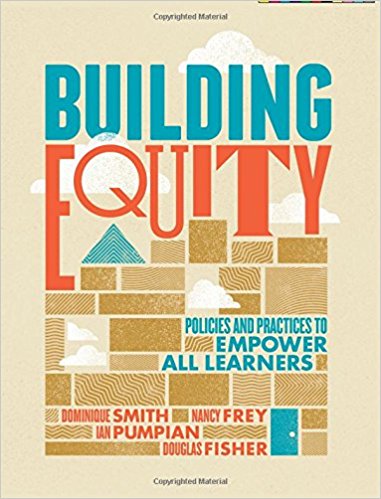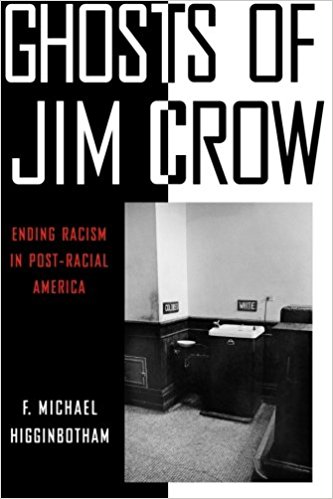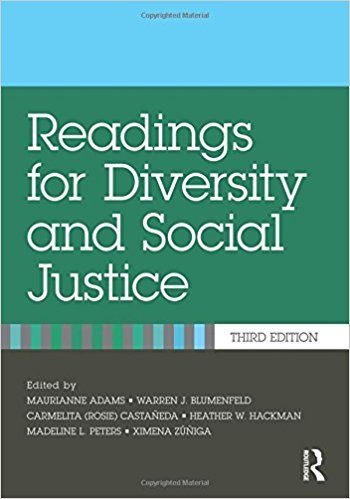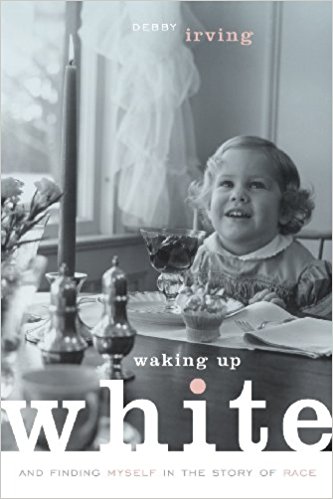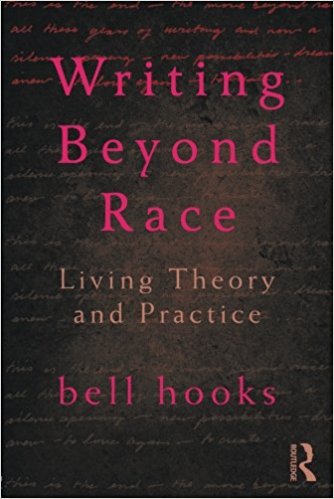Race, Racism, and Racial Bias
Yale Study Probes the Complexity of Bias in Preschool (2016)
~ Education Week | Christina Samuels
Media
Chimamanda Ngozi Adichie: The Danger of a Single Story (2009)
~ Ted.com
Our lives, our cultures, are composed of many overlapping stories. Novelist Chimamanda Adichie tells the story of how she found her authentic cultural voice -- and warns that if we hear only a single story about another person or country, we risk a critical misunderstanding.
How to Overcome our Biases? Walk Boldly Toward Them
~ Verna Myers at TEDxBeaconStreet
Our biases can be dangerous, even deadly — as we've seen in the cases of Michael Brown in Ferguson, Missouri, and Eric Garner, in Staten Island, New York. Diversity advocate Vernā Myers looks closely at some of the subconscious attitudes we hold toward out-groups. She makes a plea to all people: Acknowledge your biases. Then move toward, not away from, the groups that make you uncomfortable. In a funny, impassioned, important talk, she shows us how.
Talking Race in the Classroom
~ Jane Bolgatz via YouTube
Author and professor Jane Bolgatz visited Marlboro College on September 22, 2009 and delivered a public lecture about the need for racial literacy and how it can incorporated into a school curriculum.
Reports and Publications
Equity Starts Early: Addressing Racial Inequities in Child Care and Early Education Policy (2017)
~ Christine Johnson-Staub | CLASP
Mental Health Issues Facing the Black Community
~ Sunshine Behavioral Health
Race in the Heartland: Wisconsin’s Extreme Racial Disparity (2019)
~ COWS - University of Wisconsin - Madison
School Discipline Data Indicators: A Guide for Districts and Schools (2017)
~ National Center for Education Evaluation and Regional Assistance, Institute of Education Sciences, U.S. Department of Education
Resources
Disrupting Inequity: Having Brave Conversations About Bias Unbounded Toolkit (2017)
~ UnboundEd.org
MSAN Monthly April Resource Guide Sample (2017)
~ Minority Student Achievement Network (MSAN)
RACE: Are We So Different?
~ American Anthropological Association
Looking through the eyes of history, science and lived experience, the RACE Project explains differences among people and reveals the reality – and unreality – of race. The story of race is complex and may challenge how we think about race and human variation, about the differences and similarities among people.
Racial Equity Glossary (2019)
~ racialequitytools.org
Social Justice and Anti-Racism in Policing: Learning Resources
~ LawyerEdu.org
Why Race Matters ~ Milwaukee Public Schools
Resources for educators to guide conversations and practices around race in school climate and PBIS framework. Includes variety of articles, videos, podcasts, activities, etc on having brave conversations about race
Organizations, Agencies, and Associations
YWCA Madison works every day to eliminate racism and empower women. Through programs in race & gender equity, job training & transportation, and housing & shelter, we create real change for women, families and communities.
Recommended Reading
American Nightmare: The History of Jim Crow (2003)
~ Jerrold M. Packard
For a hundred years after the end of the Civil War, a quarter of all Americans lived under a system of legalized segregation called Jim Crow. Together with its rigidly enforced canon of racial "etiquette," these rules governed nearly every aspect of life―and outlined draconian punishments for infractions. The purpose of Jim Crow was to keep African Americans subjugated at a level as close as possible to their former slave status. Exceeding even South Africa's notorious apartheid in the humiliation, degradation, and suffering it brought, Jim Crow left scars on the American psyche that are still felt today. American Nightmare examines and explains Jim Crow from its beginnings to its end: how it came into being, how it was lived, how it was justified, and how, at long last, it was overcome only a few short decades ago. Most importantly, this book reveals how a nation founded on principles of equality and freedom came to enact as law a pervasive system of inequality and virtual slavery. Although America has finally consigned Jim Crow to the historical graveyard, Jerrold Packard shows why it is important that this scourge―and an understanding of how it happened―remain alive in the nation's collective memory.
The Beast Side: Living and Dying While Black in America (2016)
~ D. Watkins (Author) and David Talbot (Foreword)
To many, the past 8 years under President Obama were meant to usher in a new post-racial American political era, dissolving the divisions of the past. However, when seventeen-year-old Trayvon Martin was shot by a wannabe cop in Florida; and then Ferguson, Missouri, happened; and then South Carolina hit the headlines; and then Baltimore blew up, it was hard to find any evidence of a new post-racial order. Suddenly the entire country seemed to be awakened to a stark fact: African American men are in danger in America. This has only become clearer as groups like Black Lives Matter continue to draw attention to this reality daily not only online but also in the streets of our nation’s embattled cities. Now one of our country’s quintessential urban war zones is brought powerfully to life by a rising young literary talent, D. Watkins. The author fought his way up on the eastside (the “beastside”) of Baltimore, Maryland—or “Bodymore, Murderland,” as his friends call it. He writes openly and unapologetically about what it took to survive life on the streets while the casualties piled up around him, including his own brother. Watkins pushed drugs to pay his way through school, staying one step ahead of murderous business rivals and equally predatory lawmen. When black residents of Baltimore finally decided they had had enough—after the brutal killing of twenty-five-year-old Freddie Gray while in police custody—Watkins was on the streets as the city erupted. He writes about his bleeding city with the razor-sharp insights of someone who bleeds along with it. Here are true dispatches from the other side of America.
Between the World and Me (2015)
~ Ta-Nehisi Coates
In a profound work that pivots from the biggest questions about American history and ideals to the most intimate concerns of a father for his son, Ta-Nehisi Coates offers a powerful new framework for understanding our nation’s history and current crisis. Americans have built an empire on the idea of “race,” a falsehood that damages us all but falls most heavily on the bodies of black women and men—bodies exploited through slavery and segregation, and, today, threatened, locked up, and murdered out of all proportion. What is it like to inhabit a black body and find a way to live within it? And how can we all honestly reckon with this fraught history and free ourselves from its burden? Between the World and Me is Ta-Nehisi Coates’s attempt to answer these questions in a letter to his adolescent son. Coates shares with his son—and readers—the story of his awakening to the truth about his place in the world through a series of revelatory experiences, from Howard University to Civil War battlefields, from the South Side of Chicago to Paris, from his childhood home to the living rooms of mothers whose children’s lives were taken as American plunder. Beautifully woven from personal narrative, reimagined history, and fresh, emotionally charged reportage, Between the World and Me clearly illuminates the past, bracingly confronts our present, and offers a transcendent vision for a way forward.
Blindspot: Hidden Biases of Good People (2016)
~ Mahzarin R. Banaji and Anthony G. Greenwald
I know my own mind.
I am able to assess others in a fair and accurate way.
These self-perceptions are challenged by leading psychologists Mahzarin R. Banaji and Anthony G. Greenwald as they explore the hidden biases we all carry from a lifetime of exposure to cultural attitudes about age, gender, race, ethnicity, religion, social class, sexuality, disability status, and nationality.“Blindspot” is the authors’ metaphor for the portion of the mind that houses hidden biases. Writing with simplicity and verve, Banaji and Greenwald question the extent to which our perceptions of social groups—without our awareness or conscious control—shape our likes and dislikes and our judgments about people’s character, abilities, and potential.The authors reveal hidden biases based on their experience with the Implicit Association Test, a method that has revolutionized the way scientists learn about the human mind and that gives us a glimpse into what lies within the metaphoric blindspot. The title’s “good people” are those of us who strive to align our behavior with our intentions. The aim of Blindspot is to explain the science in plain enough language to help well-intentioned people achieve that alignment. By gaining awareness, we can adapt beliefs and behavior and “outsmart the machine” in our heads so we can be fairer to those around us. Venturing into this book is an invitation to understand our own minds.
Building Equity: Policies and Practices to Empower All Learners (2017)
~ Dominique Smith, Nancy Frey, Ian Pumpian, Douglas Fisher
Imagine a school with a diverse student body where every student feels safe and valued, and all students—regardless of race, culture, home language, sexual orientation, gender identity, academic history, and individual challenges—have the opportunity to succeed with challenging classes, projects, and activities. In this school, teachers notice and meet students' individual instructional needs and foster a harmonious and supportive environment—and students feel empowered to learn, to grow, and to pursue their dreams. This is the school all our students need and deserve. In Building Equity, Dominique Smith, Nancy Frey, Ian Pumpian, and Douglas Fisher, colleagues at San Diego's innovative Health Sciences High & Middle College, introduce the School Equity Taxonomy, a new model to clarify the structural and interpersonal components of an equitable and excellent schooling experience, and the School Equity Audit, a survey-based tool to help school and teacher leaders uncover equity-related issues and organize their efforts to better address. Built on the authors' own experiences and those of hundreds of educators throughout the United States, this book is filled with examples of policy initiatives and practices that support critical standards of equity and high-quality, inclusive learning experiences.
Can We Talk about Race?: And Other Conversations in an Era of School Resegregation (Race, Education, and Democracy) (2008)
~ Beverly Tatum
In this ambitious, accessible book, Tatum examines some of the most resonant issues in American education and race relations: (a) The need of African American students to see themselves reflected in curricula and institutions; (b) How unexamined racial attitudes can negatively affect minority-student achievement; (c) The possibilities—and complications—of intimate crossracial friendships. Tatum approaches all these topics with the blend of analysis and storytelling that make her one of our most persuasive and engaging commentators on race. Can We Talk About Race? launches a collaborative lecture and book series between Beacon Press and Simmons College, which aims to reinvigorate a crucial national public conversation on race, education and democracy.
The Color of Law: A Forgotten History of How our Government Segregated America (2017)
~ Richard Rothstein
Richard Rothstein’s The Color of Law offers “the most forceful argument ever published on how federal, state, and local governments gave rise to and reinforced neighborhood segregation” (William Julius Wilson). Exploding the myth of de facto segregation arising from private prejudice or the unintended consequences of economic forces, Rothstein describes how the American government systematically imposed residential segregation: with undisguised racial zoning; public housing that purposefully segregated previously mixed communities; subsidies for builders to create whites-only suburbs; tax exemptions for institutions that enforced segregation; and support for violent resistance to African Americans in white neighborhoods.
Colormute: Race Talk Dilemmas in an American School (2005)
~ Mica Pollock
This book considers in unprecedented detail one of the most confounding questions in American racial practice: when to speak about people in racial terms. Viewing "race talk" through the lens of a California high school and district, Colormute draws on three years of ethnographic research on everyday race labeling in education. Based on the author's experiences as a teacher as well as an anthropologist, it discusses the role race plays in everyday and policy talk about such familiar topics as discipline, achievement, curriculum reform, and educational inequality. Pollock illustrates the wide variations in the way speakers use race labels. Sometimes people use them without thinking twice; at other moments they avoid them at all costs or use them only in the description of particular situations. While a major concern of everyday race talk in schools is that racial descriptions will be inaccurate or inappropriate, Pollock demonstrates that anxiously suppressing race words (being what she terms "colormute") can also cause educators to reproduce the very racial inequities they abhor. The book assists readers in cultivating a greater understanding of the pitfalls and possibilities of everyday race talk and clarifies previously murky discussions of "colorblindness." By bridging the gap between theory and practice, Colormute will be enormously helpful in fostering ongoing conversations about dismantling racial inequality in America.
Courageous Conversations About Race: A Field Guide for Achieving Equity in Schools (2014)
~ Glenn E. Singleton
This updated edition of the bestseller continues to explain the need for candid, courageous conversations about race so that educators may understand why achievement inequality persists and learn how they can develop a curriculum that promotes true educational equity and excellence.
Critical Race Theory: The Cutting Edge (2013)
~ Jean Stefancic and Richard Delgado (Editors)
Critical Race Theory has become a dynamic, eclectic, and growing movement in the study of law. With this third edition of Critical Race Theory, editors Richard Delgado and Jean Stefancic have created a reader for the twenty-first century-one that shakes up the legal academy, questions comfortable liberal premises, and leads the search for new ways of thinking about our nation's most intractable, and insoluble, problem-race. The contributions, from a stellar roster of established and emerging scholars, address new topics, such as intersectionality and black men on the down low. Essays also confront much-discussed issues of discrimination, workplace dynamics, affirmative action, and sexual politics. Also new to this volume are updated section introductions, author notes, questions for discussion, and reading lists for each unit. The volume also covers the spread of the movement to other disciplines such as education.
Offering a comprehensive and stimulating snapshot of current race jurisprudence and thought, this new edition of Critical Race Theory is essential for those interested in law, the multiculturalism movement, political science, education, and critical thought.
Critical Race Theory in Education: All God's Children Got a Song (2006)
~ Adrienne D. Dixson and Celia K. Rousseau
Although Critical Race Theory (CRT) has been used to analyze difficult issues of race and racism in education for over ten years, the function of CRT in educational research is still not entirely clear. By bringing together the voices of various CRT scholars and education experts, this volume presents a comprehensive chorus of answers to the question of how and why CRT should be applied to educational scholarship. The collected chapters address CRT’s foundations in legal theory, current applications of CRT, and possible new directions for CRT in education. Appropriate for both students curious about CRT and established CRT scholars, Critical Race Theory in Education is a valuable guide to how CRT can help us better understand and seek solutions to educational inequity.
Deconstructing Privilege: Teaching and Learning as Allies in the Classroom (2013)
~ Kim A. Case (editor)
This edited collection explores best practices for effective teaching and learning about various forms of systemic group privilege such as that based on race, gender, sexuality, religion and class. Although scholarly examinations of privilege have increased in recent decades, an emphasis on privilege studies pedagogy remains lacking within institutions. This edited collection explores best practices for effective teaching and learning about various forms of systemic group privilege such as that based on race, gender, sexuality, religion, and class. Formatted in three easy-to-follow sections, Deconstructing Privilege charts the history of privilege studies and provides intersectional approaches to the topic. Drawing on a wealth of research and real-life accounts, this book gives educators both the theoretical foundations they need to address issues of privilege in the classroom and practical ways to forge new paths for critical dialogues in educational settings. Combining interdisciplinary contributions from leading experts in the field-- such as Tim Wise and Abby Ferber-- with pedagogical strategies and tips for teaching about privilege, Deconstructing Privilege is an essential book for any educator who wants to address what privilege really means in the classroom.
Eliminating Racial Profiling in School Discipline: Cultures in Conflict (2002)
~ Martha R. Bireda
Referrals, suspensions, and expulsions of African American students, especially males, are at an all-time high. However, as this book shows, culturally determined assumptions and friction over communication have a role to play in this as well. Eliminating Racial Profiling in School Discipline is designed to make readers aware of how cultural factors relate to the ways that discipline is meted out. Administrators and teachers will gain an understanding of how culturally conditioned beliefs and assumptions negatively influence student-teacher relationships. Ultimately, this book proposes a set of strategies to solve increased disciplinary referrals.
Everyday Antiracism: Getting Real About Race in School (2008)
~ Mica Pollock
Which acts by educators are "racist" and which are "antiracist"? How can an educator constructively discuss complex issues of race with students and colleagues? In Everyday Antiracism, leading educators deal with the most challenging questions about race in school, offering invaluable and effective advice. Contributors including Beverly Daniel Tatum, Sonia Nieto, and Pedro Noguera describe concrete ways to analyze classroom interactions that may or may not be "racial," deal with racial inequality and "diversity," and teach to high standards across racial lines. Topics range from using racial incidents as teachable moments and responding to the "n-word" to valuing students' home worlds, dealing daily with achievement gaps, and helping parents fight ethnic and racial misconceptions about their children. Questions following each essay prompt readers to examine and discuss everyday issues of race and opportunity in their own classrooms and schools. For educators and parents determined to move beyond frustrations about race, Everyday Antiracism is an essential tool.
Faces At The Bottom of The Well: The Permanence of Racism (1993)
~ Derrick Bell
The noted civil rights activist uses allegory and historical example to present a radical vision of the persistence of racism in America. These essays shed light on some of the most perplexing and vexing issues of our day: affirmative action, the disparity between civil rights law and reality, the “racist outbursts” of some black leaders, the temptation toward violent retaliation, and much more.
Foundations of Critical Race Theory in Education (Critical Educator) (1st Ed., 2009)
~ Edward Taylor, David Gillborn, Gloria Ladson-Billings (Editors)
The emergence of Critical Race Theory (CRT) marked an important point in the history of racial politics in the legal academy and the broader conversation about race and racism in the United States. More recently, CRT has proven an important analytic tool in the field of education, offering critical perspectives on race, and the causes, consequences and manifestations of race, racism, inequity, and the dynamics of power and privilege in schooling. This groundbreaking anthology is the first to pull together both the foundational writings in the field and more recent scholarship on the cultural and racial politics of schooling. A comprehensive introduction provides an overview of the history and tenets of CRT in education. Each section then seeks to explicate ideological contestation of race in education and to create new, alternative accounts. In so doing, this landmark publication not only documents the progress to date of the CRT movement, it acts to further spur developments in education.
Ghosts of Jim Crow: Ending Racism in Post-Racial America (2015)
~ F. Michael Higginbotham
When America inaugurated its first African American president, in 2009, many wondered if the country had finally become a "post-racial" society. Was this the dawning of a new era, in which America, a nation nearly severed in half by slavery, and whose racial fault lines are arguably among its most enduring traits, would at last move beyond race with the election of Barack Hussein Obama? In Ghosts of Jim Crow, F. Michael Higginbotham convincingly argues that America remains far away from that imagined utopia. Indeed, the shadows of Jim Crow era laws and attitudes continue to perpetuate insidious, systemic prejudice and racism in the 21st century. Higginbotham’s extensive research demonstrates how laws and actions have been used to maintain a racial paradigm of hierarchy and separation—both historically, in the era of lynch mobs and segregation, and today—legally, economically, educationally and socially. Using history as a roadmap, Higginbotham arrives at a provocative solution for ridding the nation of Jim Crow’s ghost, suggesting that legal and political reform can successfully create a post-racial America, but only if it inspires whites and blacks to significantly alter behaviors and attitudes of race-based superiority and victimization. He argues that America will never achieve its full potential unless it truly enters a post-racial era, and believes that time is of the essence as competition increases globally.
Jim Crow Guide to the U.S.A.: The Laws, Customs and Etiquette Governing the Conduct of Nonwhites and Other Minorities as Second-Class Citizens (2011)
~ Stetson Kennedy
Jim Crow Guide documents the system of legally imposed American apartheid that prevailed during what Stetson Kennedy calls "the long century from Emancipation to the Overcoming." The mock guidebook covers every area of activity where the tentacles of Jim Crow reached. From the texts of state statutes, municipal ordinances, federal regulations, and judicial rulings, Kennedy exhumes the legalistic skeleton of Jim Crow in a work of permanent value for scholars and of exceptional appeal for general readers.
More Courageous Conversations About Race (2012)
~ Glenn E. Singleton
In this companion to his best-selling book, Glenn Singleton presents specific examples in which racism impedes student success and illustrates how to usher in courageous conversations to ignite systemic transformation. Through first-person vignettes and an actual school district case study, this breakthrough handbook focuses on the powerful possibilities that are unleashed when you: (a) Learn how other education leaders have addressed and improved race relations; (b) Explore urgent challenges in racial equity and courageous approaches to solving them; (c) Reflect on your personal role in the struggle to achieve racial equity; and (d) Introduce culturally relevant curriculum, instruction, and assessment in your school or district.
The New Jim Crow: Mass Incarceration in the Age of Colorblindness (2012)
~ Michelle Alexander and Cornel West
Once in a great while a book comes along that changes the way we see the world and helps to fuel a nationwide social movement. The New Jim Crow is such a book. Praised by Harvard Law professor Lani Guinier as "brave and bold," this book directly challenges the notion that the election of Barack Obama signals a new era of colorblindness. With dazzling candor, legal scholar Michelle Alexander argues that "we have not ended racial caste in America; we have merely redesigned it." By targeting black men through the War on Drugs and decimating communities of color, the U.S. criminal justice system functions as a contemporary system of racial control—relegating millions to a permanent second-class status—even as it formally adheres to the principle of colorblindness. In the words of Benjamin Todd Jealous, president and CEO of the NAACP, this book is a "call to action."
Other People's Children: Cultural Conflict in the Classroom (2006)
~ Lisa Delpit
Winner of an American Educational Studies Association Critics’ Choice Award and Choice Magazine’s Outstanding Academic Book Award, and voted one of Teacher Magazine’s “great books,” Other People’s Children has sold over 150,000 copies since its original hardcover publication. This anniversary paperback edition features a new introduction by Delpit as well as new framing essays by Herbert Kohl and Charles Payne. In a radical analysis of contemporary classrooms, MacArthur Award–winning author Lisa Delpit develops ideas about ways teachers can be better “cultural transmitters” in the classroom, where prejudice, stereotypes, and cultural assumptions breed ineffective education. Delpit suggests that many academic problems attributed to children of color are actually the result of miscommunication, as primarily white teachers and “other people’s children” struggle with the imbalance of power and the dynamics plaguing our system. A new classic among educators, Other People’s Children is a must-read for teachers, administrators, and parents striving to improve the quality of America’s education system.
Post Traumatic Slave Syndrome: America's Legacy of Enduring Injury and Healing (Rev. ed., 2017)
~ Joy Degruy
In the 16th century, the beginning of African enslavement in the Americas until the ratification of the Thirteenth Amendment and emancipation in 1865, Africans were hunted like animals, captured, sold, tortured, and raped. They experienced the worst kind of physical, emotional, psychological, and spiritual abuse. Given such history, isn't it likely that many of the enslaved were severely traumatized? And did the trauma and the effects of such horrific abuse end with the abolition of slavery? Emancipation was followed by one hundred more years of institutionalized subjugation through the enactment of Black Codes and Jim Crow laws, peonage, convict leasing, domestic terrorism and lynching. Today the violations continue, and when combined with the crimes of the past, they result in yet unmeasured injury. What do repeated traumas, endured generation after generation by a people produce? What impact have these ordeals had on African Americans today? Dr. Joy DeGruy, answers these questions and more. With over thirty years of practical experience as a professional in the mental health field, Dr. DeGruy encourages African Americans to view their attitudes, assumptions, and behaviors through the lens of history and so gain a greater understanding of how centuries of slavery and oppression have impacted people of African descent in America. Post Traumatic Slave Syndrome helps to lay the necessary foundation to ensure the well-being and sustained health of future generations and provides a rare glimpse into the evolution of society's beliefs, feelings, attitudes and behavior concerning race in America.
Privilege, Power and Difference (2005)
~ Allan G. Johnson
This brief book is a groundbreaking tool for students and non-students alike to examine systems of privilege and difference in our society. Written in an accessible, conversational style, Johnson links theory with engaging examples in ways that enable readers to see the underlying nature and consequences of privilege and their connection to it. This extraordinarily successful book has been used across the country, both inside and outside the classroom, to shed light on issues of power and privilege.
Race, Racism & American Law (2008)
~ Derrick A. Bell
The Sixth Edition of this innovative text written by Derrick Bell continues to provide students with insight into the issues surrounding race in America and an understanding of how the law interprets those issues as well as the factors that directly and indirectly influence the law. The first casebook published specifically for teaching race related law courses, Race, Racism, and American Law is engaging, offering hard-hitting enlightenment, and is an unparalleled teaching tool. Among the features that have made this text a success with both students and instructors through five editions over 35 years: (a) Clear and readable text along with a participatory approach that encourages discussion of unresolved and perhaps unresolvable racial issues; (b) Interdisciplinary excerpts from historical, sociological, and psychological publications that provide comprehensive coverage of all aspects of the subject; (c) and in this edition pose the question of the law’s limitations in remedying current racial barriers. The presentations promote learning by teaching experience that enables students to realize the complex nature and consequences of racism in the United States. Commentary on the Supreme Court's conception of a color-blind society and its adverse effects on school desegregation, voting, employment, and affirmative action. Alternatives to integration in achieving the goal of equal educational opportunity. The absence or inadequacy of remedies for racial barriers facing Latino, Asian and Native American citizens. Discussion of Professor Lani Guinier's advocacy of proportional representation over majority-minority districts. The uses of nooses as racial intimidation symbols replacing flaming crosses. Racial priorities in Hurricane Katrina rescue and recovery policies. The legal ramifications of the disproportionately high percentage of blacks and Hispanics in American prisons Legal and social barriers to blacks and Latinos seeking to challenge employment discrimination under Title VII of the Civil Rights Act of 1964, as amended. The growing acceptance and continued hostility to interracial sex and marriage. The vulnerability of black and Latino buyers to consumer schemes and sub-prime mortgages. The limited value of racial protests during a time of war and national crisis.
Racial Inequity in Special Education (2002)
~ Daniel J. Losen and Gary Orfield (Editors)
An illuminating account of a widespread problem that has received little attention, Racial Inequity in Education sets the stage for a more fruitful discussion about special education and racial justice. Racial inequities pervade special education in U.S. schools today. Minority children—especially African Americans—are far more likely than white children to be designated mentally retarded or emotionally disturbed and therefore in need of special education. Even when appropriately placed in special education classes, minority children often receive poorer services than disabled white children. This book explores the inequities experienced by minority schoolchildren in special education. These issues are examined as problems in their own right, and as reflections of persistent racial inequities in our system of public education. Racial Inequity in Special Education describes the scope of these problems, and provides a comprehensive review of attempts by legislators, child advocates, and educational and civil rights enforcement agencies to address these complex issues. The authors outline essential areas for further research and dialogue.
Racing to Justice: Transforming Our Conceptions of Self and Other to Build an Inclusive Society (2015)
~ John A. Powell
Renowned social justice advocate John A. Powell persuasively argues that we have not achieved a post-racial society and that there is much work to do to redeem the American promise of inclusive democracy. Culled from a decade of writing about social justice and spirituality, these meditations on race, identity, and social policy provide an outline for laying claim to our shared humanity and a way toward healing ourselves and securing our future. Racing to Justice challenges us to replace attitudes and institutions that promote and perpetuate social suffering with those that foster relationships and a way of being that transcends disconnection and separation.
Racism without Racists: Color-Blind Racism and the Persistence of Racial Inequality in America
(2nd ed., 2009)
~ Eduardo Bonilla-Silva
The first edition of this best-selling book showed that alongside the subtle forms of discrimination typical of the post-Civil Rights era, new powerful ideology of "color-blind racism" has emerged. Bonilla-Silva documented how beneath the rhetorical maze of contemporary racial discourse lies a full-blown arsenal of arguments, phrases, and stories that whites use to account for and ultimately justify racial inequities. In the new edition, Bonilla-Silva has added a chapter dealing with the future of racial stratification in America that goes beyond the white / black dichotomy. He argues that the U.S. is developing a more complex and apparently "plural" racial order that will mimic Latin American patterns of racial stratification. Another new chapter addresses a variety of questions from readers of the first edition. And he has updated the book throughout with new information, data, and references where appropriate. The book ends with a new Postscript, "What is to be Done (For Real?)". As in the highly acclaimed first edition, Bonilla-Silva continues to challenge color-blind thinking.
Racism without Racists: Color-Blind Racism and the Persistence of Racial Inequality in America
(4th ed., 2013)
~ Eduardo Bonilla-Silva
Eduardo Bonilla-Silva’s acclaimed Racism without Racists documents how, beneath our contemporary conversation about race, lies a full-blown arsenal of arguments, phrases, and stories that whites use to account for—and ultimately justify—racial inequalities. This provocative book explodes the belief that America is now a color-blind society. The fourth edition adds a chapter on what Bonilla-Silva calls "the new racism," which provides the essential foundation to explore issues of race and ethnicity in more depth. This edition also updates Bonilla-Silva’s assessment of race in America after President Barack Obama’s re-election. Obama’s presidency, Bonilla-Silva argues, does not represent a sea change in race relations, but rather embodies disturbing racial trends of the past.
Racism without Racists: Color-Blind Racism and the Persistence of Racial Inequality in America
(5th ed., 2017)
~ Eduardo Bonilla-Silva
Eduardo Bonilla-Silva’s acclaimed Racism without Racists documents how, beneath our contemporary conversation about race, there lies a full-blown arsenal of arguments, phrases, and stories that whites use to account for—and ultimately justify—racial inequalities. The fifth edition of this provocative book makes clear that color blind racism is as insidious now as ever. It features new material on our current racial climate, including the Black Lives Matter movement; a significantly revised chapter that examines the Obama presidency, the 2016 election, and Trump’s presidency; and a new chapter addressing what readers can do to confront racism—both personally and on a larger structural level.
Readings for Diversity and Social Justice: An Anthology on Racism, Antisemitism, Sexism, Heterosexism, Ableism, and Classism (1st ed., 2000)
~ Maurianne Adams, Warren J. Blumenfeld, Carmelita (Rosie) Castañeda, Heather W. Hackman, Madeline L. Peters, Ximena Zúñiga (Editors)
The first reader to cover the scope of oppressions in America, Readings for Diversity and Social Justice covers six thematic issues: racism, sexism, Anti-Semitism, heterosexism, classism, and ableism. The reader contains a mix of short personal and theoretical essays as well as entries designed to challenge students to take action to end oppressive behavior and to affirm diversity and racial justice.
Readings for Diversity and Social Justice: An Anthology on Racism, Antisemitism, Sexism, Heterosexism, Ableism, and Classism (3rd ed., 2013)
~ Maurianne Adams, Warren J. Blumenfeld, Heather W. Hackman, Madeline L. Peters, Ximena Zúñiga (Editors)
For more than a decade, Readings for Diversity and Social Justice has been the trusted, leading anthology to cover the full range of social oppressions from a social justice standpoint. With full sections dedicated to racism, sexism, classism, heterosexism, and ableism, as well as transgender oppression, religious oppression, and adult and ageism, this bestselling text goes far beyond the range of traditional readers. New essay selections in each section of this third edition have been carefully chosen to keep topic coverage timely and readings accessible and engaging for students. The interactions among these topics are highlighted throughout to stress the interconnections among oppressions in everyday life. Retaining the key features and organization that has made Readings for Diversity and Social Justice an indispensable text for teaching issues of social justice while simultaneously updating and expanding its coverage, this new edition features: (a) Over 20 new selections considering current topics and events such as immigration trends, racial profiling, student debt, Occupy Wall Street and global GLBT rights. (b) An updated companion website with additional resources, including video clips that further complement the readings in each section. Strong and accessible section introductions to highlight key points and relate the essential concepts of any given topic to other forms of oppression. (c) An explicit emphasis on the interconnectedness of social identity and social inequality throughout, with a second table of contents that notes the intersections among readings.
Remembering Jim Crow: African Americans Tell About Life in the Segregated South (2003)
~ William Henry Chafe and Raymond Gavins (Editors)
Based on interviews collected by the Behind the Veil Project at Duke University's Center for Documentary Studies, this remarkable book presents the most extensive oral history ever of African American life under segregation.Citing Remembering Jim Crow as a Best Book of the Year for 2001, Library Journal wrote that "]when] the segregation era finally passes from living memory, students of its history will look to sources like this for a shivering dose of reality and inspiring stories of everyday resistance." In vivid, compelling accounts, men and women from all walks of life tell how their day-to-day activity was subjected to profound and unrelenting racial oppression. At the same time, Remembering Jim Crow is a testament to how black southerners fought back against the system, raising children, building churches and schools, running businesses, and struggling for respect in a society that denied them the most basic rights.
Rethinking the Color Line: Readings in Race and Ethnicity (2014)
~ Charles A. Gallagher
User-friendly without sacrificing intellectual or theoretical rigor, this anthology of current research examines contemporary issues and explores new approaches to the study of race and ethnic relations. The featured readings effectively engage students by helping them understand theories and concepts. Active learning in the classroom is encouraged while providing relevance for students from all ethnic, cultural, and economic backgrounds. The fifth edition features ten new articles on such timely topics as:
(a) The U.S. Census' changing definition of race and ethnicity' (b) Race-based disparities in health; (c) Racial and gender discrimination among racial minorities and women; (d) Being Arab and American; (e) How social control maintains racial inequality; (f) The increase in black and brown incarceration; (g) How racial bias may affect the use of DNA to locate suspects of crimes; (h) How derogatory ethnic and racial images are created and disseminated by the media; (i) The sexualization of African American women through the use of gender stereotypes; (j) The portrayal of light- and dark-skinned biracial characters
Silent Covenants: Brown v. Board of Education and the Unfulfilled Hopes for Racial Reform (2005)
~ Derrick Bell
When the landmark Supreme Court case of Brown vs. Board of Education was handed down in 1954, many civil rights advocates believed that the decision, which declared public school segregation unconstitutional, would become the Holy Grail of racial justice. Fifty years later, despite its legal irrelevance and the racially separate and educationally ineffective state of public schooling for most black children, Brown is still viewed by many as the perfect precedent.Here, Derrick Bell shatters the shining image of this celebrated ruling. He notes that, despite the onerous burdens of segregation, many black schools functioned well and racial bigotry had not rendered blacks a damaged race. He maintains that, given what we now know about the pervasive nature of racism, the Court should have determined instead to rigorously enforce the "equal" component of the "separate but equal" standard. Racial policy, Bell maintains, is made through silent covenants--unspoken convergences of interest and involuntary sacrifices of rights--that ensure that policies conform to priorities set by policy-makers. Blacks and whites are the fortuitous winners or losers in these unspoken agreements. The experience with Brown, Bell urges, should teach us that meaningful progress in the quest for racial justice requires more than the assertion of harms. Strategies must recognize and utilize the interest-convergence factors that strongly influence racial policy decisions.In Silent Covenants, Bell condenses more than four decades of thought and action into a powerful and eye-opening book.
Start Where You Are, But Don’t Stay There: Understanding Diversity, Opportunity Gaps, and Teaching in Today’s Classrooms (2010)
~ H. Richard Milner IV (Author), Gloria Ladson-Billings (Foreword)
Start Where You Are, But Don’t Stay There addresses a crucial issue in teacher training and professional education: the need to prepare pre-service and in-service teachers for the racially diverse student populations in their classrooms. A down-to-earth book, it aims to help practitioners develop insights and skills for successfully educating diverse student bodies. The book centers on case studies that exemplify the challenges, pitfalls, and opportunities facing teachers in diverse classrooms. These case studies―of white and African American teachers working (and preparing to work) in urban and suburban settings―are presented amid more general discussions about race and teaching in contemporary schools. Informing these discussions and the cases themselves is their persistent attention to opportunity gaps that need to be fully grasped by teachers who aim to understand and promote the success of students of greatly varying backgrounds. Start Where You Are, But Don’t Stay There arises out of recent scholarship about race and education, but it is more directly inspired by the pressing need for useful and credible guidance for professional educators in diverse classrooms. It will prove indispensable to teachers, administrators, and scholars alike.
Waking Up White, and Finding Myself in the Story of Race (2014)
~ Debby Irving
Waking Up White is the book Irving wishes someone had handed her decades ago. By sharing her sometimes cringe-worthy struggle to understand racism and racial tensions, she offers a fresh perspective on bias, stereotypes, manners, and tolerance. As Irving unpacks her own long-held beliefs about colorblindness, being a good person, and wanting to help people of color, she reveals how each of these well-intentioned mindsets actually perpetuated her ill-conceived ideas about race. She also explains why and how she's changed the way she talks about racism, works in racially mixed groups, and understands the antiracism movement as a whole. Exercises at the end of each chapter prompt readers to explore their own racialized ideas. Waking Up White's personal narrative is designed to work well as a rapid read, a book group book, or support reading for courses exploring racial and cultural issues.
We Can't Teach What We Don't Know: White Teachers, Multiracial Schools, 2nd ed. (2006)
~ Gary R. Howard and James A. Banks
Gary Howard outlines what good teachers know, what they do, and how they embrace culturally responsive teaching. Howard brings his bestselling book completely up to date with today’s school reform efforts and includes a new introduction and a new chapter that speak directly to current issues such as closing the achievement gap, and to recent legislation such as No Child Left Behind. With our nation’s student population becoming ever more diverse, and teachers remaining largely White, this book is now more important than ever. A must-read in universities and school systems throughout the country, We Can’t Teach What We Don’t Know continues to facilitate and deepen the discussion of race and social justice in education.
We Can't Teach What We Don't Know: White Teachers, Multiracial Schools, 3rd ed. (2016)
~ Gary R. Howard
Making a case for the “fierce urgency of now,” this new edition deepens the discussion of race and social justice in education with new and updated material. Aligned with our nation’s ever more diverse student population, it speaks to what good teachers know, what they do, and how they embrace culturally responsive teaching. This essential text is widely used in teacher preparation courses and for in-service professional development. New for the Third Edition: (a) A revised Introduction that places the book in the context of the 50th anniversary of the 1963 march on Washington; (b) An updated analysis of White social dominance, bringing in Critical Race Theory and reflecting on the racist reaction to the election of our first Black President; (c) More detail to the White Identity Orientations model, bringing in the personal life experiences of several contemporary White racial-justice activists; (d) A new section, “The Whiteness of School Reform,” demonstrating how White social dominance drives much of the corporate school reform movement; (e) A richer discussion of the seven principles for Culturally Responsive Teaching, drawing lessons from the author’s transformative work with school districts throughout the country; (f) An expanded Reflection and Discussion Guide authored by two educators who have been using the book in professional development sessions for many years.
What if All the Kids are White? Anti-Bias Multicultural Education with Young Children and Families (2006)
~ Louise Derman-Sparks and Patricia G. Ramsey
In this compelling volume, distinguished educators tackle a frequently asked question about multicultural education: How do I teach about racial and cultural diversity if all my students are white? The authors propose seven learning themes to help young white children resist messages of racism and build identity and skills for thriving in a multicultural country and world. The text includes strategies, resources, and classroom examples for implementing the learning themes in early childhood settings. Taking multicultural education to a new level, this practical guide: places the development of white children's racial identity in the context of the historical construction of "whiteness" and racism in America; suggests strategies for nurturing a new white identity as the starting place for antibias/multicultural work with children; offers ways to expand children's interests and concerns beyond their immediate world to instill a sense of caring and connection toward people different from them and to encourage seeing themselves as agents of change; and includes activities for families and staff, reflection questions, a review of white anti-racism activists, lists of suggested children's books, and organizational and website resources.
What's the Matter with White People? Why We Long for a Golden Age That Never Was (2012)
~ Joan Walsh
The size and stability of the American middle class were once the envy of the world. But changes unleashed in the 1960s pitted Americans against one another politically in new and destructive ways. These battles continued to rage from that day to now, while everyone has fallen behind economically except the wealthy. Right-wing culture warriors blamed the decline on the moral shortcomings of "other" Americans—black people, feminists, gays, immigrants, union members—to court a fearful white working- and middle-class base with ever more bitter "us vs. them" politics. Liberals tried, but mostly failed, to make the case that we're all in this together. In What's the Matter with White People?, popular Salon columnist Joan Walsh argues that the biggest divide in America today is not about party or ideology, but about two competing narratives for why everything has fallen apart since the 1970s. One side sees an America that has spent the last forty years bankrupting the country providing benefits and advantages to the underachieving, the immoral, and the undeserving, no matter the cost to Middle America. The other sees an America that has spent the last forty years bankrupting the country providing benefits and advantages to the very rich, while allowing a measure of cultural progress for the different and the downtrodden. It matters which side is right, and how the other side got things so wrong.
Whistling Vivaldi: How Stereotypes Affect Us and What We Can Do (2011)
~ Claude Steele
Claude M. Steele, who has been called “one of the few great social psychologists,” offers a vivid first-person account of the research that supports his groundbreaking conclusions on stereotypes and identity. He sheds new light on American social phenomena from racial and gender gaps in test scores to the belief in the superior athletic prowess of black men, and lays out a plan for mitigating these “stereotype threats” and reshaping American identities.
White Like Me: Reflections on Race from a Privileged Son (2004)
~ Tim Wise
In White Like Me, Tim Wise offers a highly personal examination of the ways in which racial privilege shapes the lives of most white Americans, overtly racist or not, to the detriment of people of color, themselves, and society. The book shows the breadth and depth of the phenomenon within institutions such as education, employment, housing, criminal justice, and healthcare. By critically assessing the magnitude of racial privilege and its enormous costs, Wise provides a rich memoir that will inspire activists, educators, or anyone interested in understanding the way that race continues to shape the experiences of people in the U.S. Using stories instead of stale statistics, Wise weaves a narrative that is at once readable and scholarly, analytical and accessible.
White Privilege: Essential Readings on the Other Side of Racism (2nd ed., 2004)
~ Paula S. Rothenberg
Studies of racism often focus on its devastating effects on the victims of prejudice. But no discussion of race is complete without exploring the other side--the ways in which some people or groups actually benefit, deliberately or inadvertently, from racial bias. White Privilege, Second Edition, the revision to the ground-breaking anthology from Paula Rothenberg, continues her efforts from the first edition. Two new essays contribute to the discussion of the nature and history of white power. The concluding section again challenges readers to explore ideas for using the power and the concept of white privilege to help combat racism in their own lives. Brief, inexpensive, and easily integrated with other texts, this interdisciplinary collection of commonsense, non-rhetorical readings lets educators incorporate discussions of whiteness and white privilege into a variety of disciplines, including sociology, English composition, psychology, social work, women's studies, political science, and American studies.
White Privilege: Essential Readings on the Other Side of Racism (5th ed., 2015)
~ Paula S. Rothenberg
Vital, eye-opening, and powerful, this unique anthology expertly presents the significance and complexity of whiteness today and illuminates the nature of privilege and power in our society. White Privilege leads students through the ubiquity and corresponding invisibility of whiteness; the historical development of whiteness and its role in race relations over time; the real everyday effects of privilege and its opposite, oppression; and finally, how our system of privilege can be changed. The thoroughly updated fifth edition explores: (a) color-blind racism; (b) virtual probation; (c) socioeconomic privilege versus. racial privilege; (d) racial profiling; (e) how immigration and questions of citizenship are historically tied to understandings of race; (f) the racial positioning of groups that are neither white nor black; (g) the commonalities and diverse experiences of people of color; (h) "flying while brown"; (i) the politics of respectability in the age of Obama, and more.
White Teachers / Diverse Classrooms: Creating Inclusive Schools, Building on Students’ Diversity, and Providing True Educational Equity (2011)
~ Julie Landsman and Chance W. Lewis
The point of departure for this new edition, as it was for the first, is the unacceptable reality that, for students of color, school is often not a place to learn but a place of low expectations and failure. In urban schools with concentrations of poverty, often fewer than half the ninth graders leave with a high school diploma. This second edition has been considerably expanded with chapters that illuminate the Asian American, Native American, and Latina/o experience, including that of undocumented students, in our schools. These chapters offer insights into the concerns and issues students bring to the classroom. They also convey the importance for teachers, as they accept difference and develop cultural sensitivity, to see their students as individuals, and avoid generalizations. This need to go beneath the surface is reinforced by a chapter on adopted children, children of mixed race, and “hidden minorities”. White and Black teachers, and teachers of different races and ethnicities, here provide the essential theoretical background, and share their experiences and the approaches they have developed, to create the conditions – in both urban and suburban settings – that enable minority students to succeed. This book encourages reflection and self-examination, and calls for recognizing and reinforcing students’ ability to achieve. It also calls for high expectations for both teachers and students. It demonstrates what it means to recognize often-unconscious biases, confront institutional racism where it occurs, surmount stereotyping, adopt culturally relevant teaching, connect with parents and the community, and integrate diversity in all activities.
White Teachers/Diverse Classrooms: A Guide to Building Inclusive Schools, Promoting High Expectations, and Eliminating Racism (2006)
~ Edited by Julie Landsman and Chance W. Lewis
For African Americans, school is often not a place to learn but a place of low expectations and failure. In urban schools with concentrations of poverty, often fewer than half the ninth graders leave with a high school diploma. Black and White teachers here provide an insightful approach to inclusive and equitable teaching and illustrate its transformative power to bring about success. This book encourages reflection and self-examination, calls for understanding how students can achieve and expecting the most from them. It demonstrates what’s involved in terms of recognizing often-unconscious biases, confronting institutional racism where it occurs, surmounting stereotyping, adopting culturally relevant teaching, connecting with parents and the community, and integrating diversity in all activities. This book is replete with examples of practice and telling insights that will engage teachers in practice or in service. It should have a place in every classroom in colleges of education. Its empowering message applies not just to teachers of Black students, but illuminates teaching in every racially diverse setting.
Why Are So Many Minority Students in Special Education?: Understanding Race & Disability in Schools (2014)
~ Beth Harry and Janette Klingner
The second edition of this powerful book examines the disproportionate placement of Black and Hispanic students in special education. The authors present compelling, research-based stories representing the range of experiences faced by culturally and linguistically diverse students who fall in the liminal shadow of perceived disability. They examine the children's experiences, their families' interactions with school personnel, the teachers' and schools' estimation of the children and their families, and the school climate that influences decisions about referrals to special education. Based on the authors' 4 years of ethnographic research in a large, culturally diverse school district, the book concludes with recommendations for improving educational practice, teacher training, and policy renewal.
Writing Beyond Race: Living Theory and Practice (2012)
~ Bell Hooks
What are the conditions needed for our nation to bridge cultural and racial divides? By Writing Beyond Race, noted cultural critic Bell Hooks models the constructive ways scholars, activists, and readers can challenge and change systems of domination. This new collection of compelling essays interrogates contemporary cultural notions of race, gender, and class. From the films Precious and Crash to recent biographies of Malcolm X and Henrietta Lacks, Hooks offers provocative insights into the way race is being talked about in this "post-racial" era.











